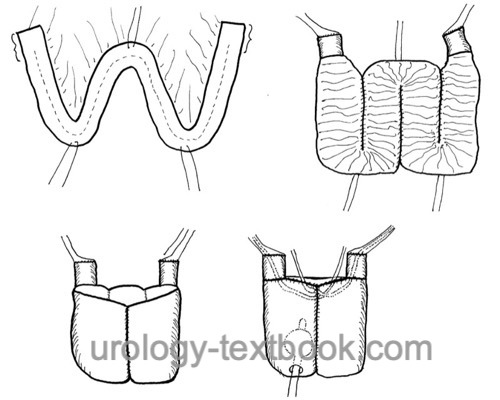You are here: Urology Textbook > Surgery (procedures) > Ileal neobladder
Ileal Neobladder: Surgical Technique (Step-by-Step) and Complications
The orthotopic ileal neobladder is a continent urinary diversion, it replaces the bladder after cystectomy and is connected to the urethra with an intact sphincter.
Indications for a Neobladder
Orthotopic ileal neobladder should be offered to motivated and medically suitable patients for orthotopic urinary diversion after cystectomy.
Contraindications for an Orthotopic Neobladder
- Carcinoma in the prostatic urethra, need for urethrectomy
- Pre-existing urinary incontinence
- Intestinal diseases (Crohn disease, ulcerative colitis, short bowel syndrome)
- Chronic kidney disease (GFR <60–80 ml/min)
- Lack of patient compliance
- Low life expectancy of the patient
- Lack of ability for self-catheterization
Step-by-Step Surgical Techniques of Ileal Neobladder
Preoperative patient preparation:
Please see the section on radical cystectomy.
Studer Ileal Neobladder:
The Studer neobladder requires 60 cm of ileum, do not use the last 20 cm of ileum [fig. Studer neobladder]. Isolate the ileal segment and perform a bowel anastomosis to reconstitute the bowel continuity. Close the mesenteric window. Carefully irrigate and clean the isolated ileal segment.
 |
- Perform a longitudinal bowel incision at the antimesenteric border. Spare the first 15 cm of the oral bowel segment.
- Ureteral anastomosis: the ureters are widely spatulated and splinted with MJ ureteral stents (secured with 4-0 fast absorbing sutures), which allows for the atraumatic management of the ureters during the next steps. Dissect the ureters as little as possible to maintain their blood supply (caution: ureteral stricture). Create a tunnel crossing the great vessels under the mesentery of the colon and bowel from the left to the right retroperitoneum with blunt finger dissection. Bring the left ureter to the right lower abdomen using the tunnel. A ureteroilial anastomosis is done comparable to an ileal conduit. The MJ stents are passed through the tubular segment (Chimney) of the bowel segment.
- Closure of the neobladder: reposition the incised bowel segment forming a U. Create a bowel plate with a running suture connecting the limbs of the U (Vicryl 3-0). Close the neobladder with two running sutures (Vicryl 3-0) after horizontally folding the bowel plate.
- Neobladder-urethral anastomosis: create a small circular incision at the most dependant portion of the neobladder and insert a 22 CH Foley urethral catheter with 30 ml balloon volume. Use the placed urethral anastomotic sutures (see section cystectomy) to complete the neobladder-urethral anastomosis.
Hautmann Ileal Neobladder:
The Hautmann neobladder requires 60–70 cm of ileum, do not use the last 20 cm of ileum [fig. Hautmann neobladder]. Isolate the ileal segment and perform a bowel anastomosis to reconstitute the bowel continuity. Close the mesenteric window. Carefully irrigate and clean the isolated ileal segment.
 |
- Reposition the bowel segment to form a W and place stay sutures for orientation. Perform a longitudinal bowel incision at the antimesenteric border. Spare the oral and aboral 3 cm of the bowel segment.
- Closure of the neobladder: create a bowel plate by connecting the limbs of the W with running sutures (Vicryl 3-0). Spatulate the ureters and splint with MJ ureteral stents (secured with 4-0 fast absorbing sutures). Perform a refluxive ureteroilial anastomosis between each ureter and the short tubular segment of the neobladder. A reposition of one ureter across the great vessels is unnecessary. Pass the MJ stents through the tubular segment (Chimney). Close the ventral wall of neobladder with running sutures.
- Neobladder-urethral anastomosis: create a small circular incision at the most dependant portion of the neobladder and insert a 22 CH Foley urethral catheter with 30 ml balloon volume. Use the placed urethral anastomotic sutures (see section cystectomy) to complete the neobladder-urethral anastomosis. Close the roof of the neobladder with a running suture, the ureteral stents exit the neobladder at the roof.
Postoperative Care after Ileum Neobladder
Please see the section urinary diversion for postoperative care.
Complications of Ileum Neobladder
In addition to the complications of cystectomy, see the section urinary diversion for complications of the continent urinary diversion.
| Ureterocutaneostomy | Index | MAINZ pouch |
Index: 1–9 A B C D E F G H I J K L M N O P Q R S T U V W X Y Z
References
Hautmann 2003 HAUTMANN, R. E.:
Urinary diversion: ileal conduit to neobladder.
In: J Urol
169 (2003), Nr. 3, S. 834–42
In: Eur Urol
16 (1989), Nr. 4, S. 241–9
Studer u.a. 1989 STUDER, U. E. ; ACKERMANN, D. ; CASANOVA, G. A. ; ZINGG, E. J.: Three years’ experience with an ileal low pressure bladder substitute.
In: Br J Urol
63 (1989), Nr. 1, S. 43–52
 Deutsche Version: Technik und Komplikationen der Ileum-Neoblase
Deutsche Version: Technik und Komplikationen der Ileum-Neoblase